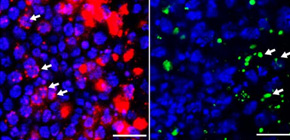
Therapeutic targets that ALS and SCA31 have in common identified
A group of researchers led by Professor ISHIKAWA Kinya at the Center for Personalized Medicine for Healthy Aging of Tokyo Medical And Dental University Medical Hospital, Specially Appointed Professor MIZUSAWA Hidehiro at the Graduate School of Medical and Dental Sciences, and Professor YOKOTA Takanori at the Department of Neurology and Neurological Science at Tokyo Medical And Dental University, in a joint research project with Director NAGAI Yoshitaka and Manager WADA Keiji at the Department of Degenerative Neurological Diseases, National Institute of Neuroscience, National Center of Neurology and Psychiatry, Japan, and researchers from Strasbourg University (France) and The Hospital for Sick Children in Toronto (Canada), discovered that neural toxicity of RNA repeat sequences that caused inherited Spinocerebellar ataxia type 31 (SCA31), which is specific to Japanese, was suppressed by amyotrophic lateral sclerosis (ALS)-linked proteins, TDP-43, FUS, hnRNPA2B1.
NAGAI Yoshitaka -- Currently: Endowed Chair Professor, Neurotherapeutics, Graduate School of Medicine, Osaka University
WADA Keiji -- Currently: Director, Translational Medical Center
This group also found that toxicity in TDP-43, FUS, hnRNPA2B1 was suppressed by nontoxic short RNA repeat sequences, which was an epoch-making discovery towards the development of treatment for SCA31and ALS.
This group’s study suggested the mechanisms by which homeostasis in vivo is kept: RNA-binding proteins (RBPs) suppress structural abnormalities in RNA through RNA- RBP interactions and RNA suppressed RBP aggregation.
This group advocates a new hypothesis of clinical condition that imbalance between RNA and proteins causes SCA31 characterized by abnormal RNA accumulation, and ALS characterized by RBP aggregation. This group also mentioned the possibility of new treatment methods for correcting this imbalance.
This group’s achievements will lead to the development of drugs for various neurodegenerative disorders in which RNA aggregation and RBP accumulation occur, and suggest potential therapeutic strategies for these diseases.
Abstract
Microsatellite expansion disorders are pathologically characterized by RNA foci formation and repeat-associated non-AUG (RAN) translation. However, their underlying pathomechanisms and regulation of RAN translation remain unknown. We report that expression of expanded UGGAA (UGGAA exp ) repeats, responsible for spinocerebellar ataxia type 31 (SCA31) in Drosophila, causes neurodegeneration accompanied by accumulation of UGGAA exp RNA foci and translation of repeat-associated pentapeptide repeat (PPR) proteins, consistent with observations in SCA31 patient brains. We revealed that motor-neuron disease (MND)-linked RNA-binding proteins (RBPs), TDP-43, FUS, and hnRNPA2B1, bind to and induce structural alteration of UGGAA exp . These RBPs suppress UGGAA exp -mediated toxicity in Drosophila by functioning as RNA chaperones for proper UGGAA exp folding and regulation of PPR translation. Furthermore, nontoxic short UGGAA repeat RNA suppressed mutated RBP aggregation and toxicity in MND Drosophila models. Thus, functional crosstalk of the RNA/RBP network regulates their own quality and balance, suggesting convergence of pathomechanisms in microsatellite expansion disorders and RBP proteinopathies.
Figure 1
Figure 2
Figure 3
Figure 4
To learn more about this research, please view the full research report entitled " Regulatory Role of RNA Chaperone TDP-43 for RNA Misfolding and Repeat-Associated Translation in SCA31 " at this page of the Neuron website.
Related link
